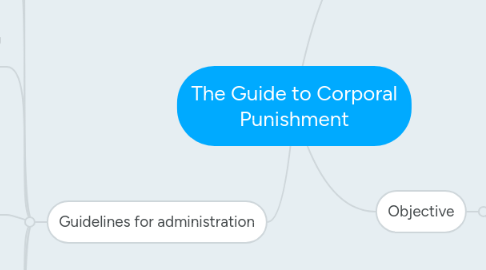
1. Guidelines for administration
1.1. Rules and Regulations and their corresponding consequences must be clearly defined by the parent/legal guardian and explained to the child
1.1.1. Have each child repeat what the authority says so it is acknowledge to be understood
1.1.2. Give each child occasional friendly reminders to save them from discipline
1.2. Consequences must be administered consistently
1.2.1. The law of cause and effect says that EVERY action has an equal and opposite reaction
1.2.2. Inconsistency teaches children the dangerous lie that there are "loop-holes" in the principle.
1.3. Consequences must be administered immediately following violations
1.3.1. A delay in the administration of the predefined consequence causes the child to misunderstand the relationship of cause and effect
1.3.2. Children should be able to physically and mentally associate the consequence with the action. The more time passes; the weaker the neural association
1.4. Consequences must be administered with something safe other than your hand
1.4.1. Your hand should be associated with love not pain.
1.4.2. A predefined tool ensures that you have considered safety and efficacy.
1.4.3. Taking time while you retrieve the tool helps you collect your thoughts and emotions before administering consequence.
1.5. Consequences must be appropriate
1.5.1. The disciplinary action should
1.5.1.1. Fit the offense
1.5.1.1.1. We like the idea of 1 spanking for breaking the rule and 2 spankings for lying about it. This helps the child understand that it is better to face the effect rather than run from the inevitable.
1.5.1.2. Lead to correction
1.5.1.2.1. Discipline that is not administered with the proper intention and in the proper manner may not lead to correction. Re-analyze and re-define the rules and consequences and try again.
1.6. Consequences must be adminstered in love without the emotion of anger
1.6.1. Kids need to know parents love for thrm
1.6.1.1. Concern for them physically, mentally and spiritually
1.6.1.2. Reaffirm your love and the reason for the consequence
1.6.1.3. Hug them
1.6.1.4. Pray with them
1.7. Restitution
1.7.1. The offender must do something to make it right
1.7.1.1. Someone with character does NOT only accept the consequences of their actions. They take responsibility for their actions and their impact on others.
1.7.1.2. Each child can develop mastery of cause and effect by seeking to restore balance to any who suffer the consequences of their actions
2. Purpose
2.1. The purpose of discipline is to raise the self esteem and self worth of each child by helping them learn to operate in alignment with the principle of cause and effect.
3. Objective
3.1. A person who can understand and take to heart the cause and effect relationship between action and consequence has outstanding advantages in life.
3.1.1. This habit is best instilled at an early age when the child is highly intelligent, able to spot patterns and learn VERY quickly.
3.1.2. This critical relationship is best internalized physically rather than mentally....
3.1.3. a safe but sharp stimulation of the nerves helps the child grasp the reality of the principle of cause and effect.
3.1.4. Thus the goal is that each child understand the principle, the reason behind the principle, and the consequences of breaking the principle.
